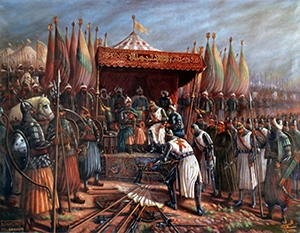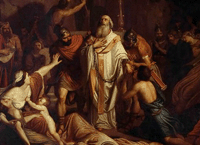
Islamic Persecutions
Christian persecution since the advent of Islam (7th century onward) has varied widely across time and regions, shaped by political, religious, and social contexts.
1. Early Islamic Period (7th–10th centuries)
Context: Rapid Islamic expansion across the Middle East, North Africa, and parts of Europe (e.g., Spain).
Status of Christians: Recognized as dhimmi (People of the Book).
Protected but subordinate: Allowed to practice Christianity in exchange for paying the jizya tax and accepting social restrictions
Restrictions: Prohibited from proselytizing, building new churches, or bearing arms; public expression of faith was limited.
Persecution examples:
2. Medieval Period (11th–15th centuries)
Crusades (1096–1291):
- Christians in Muslim lands often faced increased hostility due to associations with invading Crusaders.
- Retaliatory violence occurred in places like Jerusalem, Antioch, and later under Saladin.
- Sporadic persecution and forced conversions.
- Destruction of churches and monasteries in response to real or perceived Christian aggression.
Byzantine-Muslim conflicts:
- Christians under Muslim rule often caught in broader geopolitical struggles, leading to fluctuating treatment.
3. Ottoman Period (15th–19th centuries)
Millet system:
Christians lived in semi-autonomous religious communities (e.g., Greek Orthodox, Armenian Apostolic).
Generally tolerated but subject to:
- Legal and social inequality.
- Occasional massacres (e.g., in the Greek War of Independence, 1821).
Notable persecutions:
- Armenian, Assyrian, and Greek Christians faced growing pressure in the late 19th century due to rising nationalism and suspicion.
4. Modern Era (20th–21st centuries)
Early 20th century
Armenian Genocide (1915–1923):
- Over 1 million Armenian Christians killed by the Ottoman Empire.
- Often considered the first modern genocide.
- Targeted also were Assyrian and Greek Christians.
Post-Colonial Middle East and North Africa
Rising Arab nationalism and Islamic identity led to:
- Emigration and marginalization of Christians in Egypt, Iraq, Lebanon, Syria.
- Church bombings, mob violence, discrimination.
Recent Persecutions
- Iraq (post-2003): Sectarian violence, ISIS atrocities (e.g., Nineveh Plains cleansing).
- Syria (civil war): Christian communities caught between Islamist militants and government forces.
- Egypt: Coptic Christians have faced church bombings, mob attacks, and systemic discrimination.
- Nigeria: Boko Haram and Fulani militants have targeted Christian communities.
- Pakistan: Christians face blasphemy accusations, mob violence, and legal discrimination.
- Iran and Saudi Arabia: Evangelism criminalized; converts from Islam face imprisonment or execution.
Forms of Persecution (Post-Islamic Era)
- Legal: Blasphemy laws, apostasy laws, employment or educational discrimination.
- Social: Marginalization, threats, denial of services.
- Violent: Mob attacks, terrorist violence, targeted killings, destruction of churches.
- Forced Conversion: Especially in conflict zones or under extremist rule.
Since the 7th century, Christian persecution in Islamic contexts has ranged from tolerated minority status under legal subjugation to violent suppression and genocide. The experience of Christians has largely depended on the rulers’ policies, interreligious dynamics, and broader political conditions. While many periods were marked by coexistence, others brought severe suffering, especially during times of war, empire collapse, or rising extremism.


